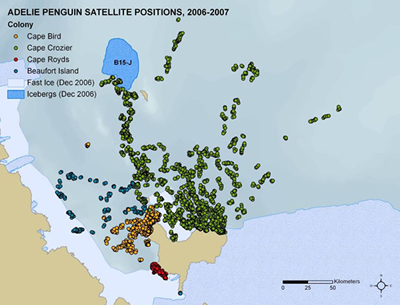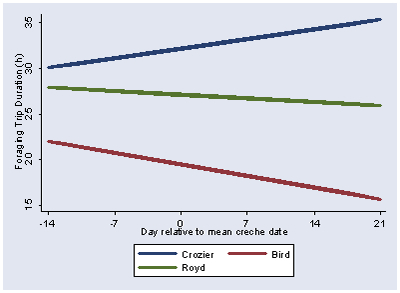Foraging trips

Penguins returning from a foraging trip. Image - Phil Lyver
Adelies act like optimal foragers as long as feeding-trips are less than 2 days, the adults did not loose condition while foraging and the chicks thrived. If the trips were longer than 2 days the adults need to metabolise some of their food load (destined to be feed to their chicks) for their own survival.
- Adults balanced self-maintenance against investment in off-spring
- Trip times and meal sizes differ between sexes, but are closely related to parent mass at the start of chick feeding
- Foraging trip duration is related directly to distance from the colony to the nearest pack ice (2 = 0.2034 ± 0.053, P = 0.002)
- Trips are longer and food loads smaller in seasons of heavier ice cover
- Foraging trip distance was greatest and tended to increase as the season progressed at Cape Crozier, the largest colony, but not at the smaller colonies, Cape Bird and Cape Royds.
Competition
 |
Satellite tracking data shows minimal foraging range over-lap between the small colonies (red and yellow circles) and the largest colony (green circles). |
 |
As chicks grow their food demands are greater and parents have to work harder (longer foraging trips) to feed their chicks, especially at Cape Crozier where competition for food is greater. |
 |
Dive depth also increase over time at Cape Crozier. |
For more information:
Ainley, D.G., Ribic, C.A., Ballard, G., Heath, S., Gaffney, I., Karl, B.J., Barton, K.J., Wilson, P.R. and Webb, S. (2004). Geographic structure of Adelie penguin populations: overlap in colony-specific foraging areas. Ecological Monographs 74(1): 159–178.
Ainley DG, Wilson PR, Barton KJ, Ballard G, Nur N, Karl B 1998. Diet and foraging effort of Adélie penguins in relation to pack-ice conditions in the southern Ross Sea. Polar Biology 20: 311–319.
Ballance LT, Ainley DG, Ballard G, Barton K 2009. An energetic correlate between colony size and foraging effort in seabirds, an example of the Adelie penguin Pygoscelis adeliae. Journal of Avian Biol. 40: 279–288.
Lescroel A ,Ballard G, Toniolo V, Barton KJ, Wilson PR, Lyver PO'B, Ainley DG. 2010.Working less to gain more: when breeding quality relates to foraging efficiency. Ecology 91(7): 2044–2055.
